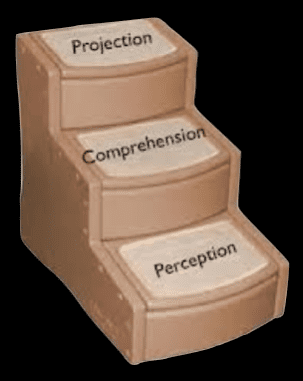 Recently I had a video clip shared with me of a residential dwelling fire. The video captures a flashover event. It was reported to me that firefighters were operating inside the structure when it occurred.
Recently I had a video clip shared with me of a residential dwelling fire. The video captures a flashover event. It was reported to me that firefighters were operating inside the structure when it occurred.
As I watched the video progress, it was apparent interior conditions were getting worse, the color of the smoke was becoming blacker, the volume of the smoke was becoming greater, the velocity of the smoke was becoming faster and the density of the smoke was becoming thicker.
Bad things were coming and it did not appear as though the crews operating on the scene could see it. Let’s explore some of the situational awareness lessons of this incident and discuss seven ways situational awareness can be stolen away.
Forming Situational Awareness
 You form your situational awareness by gathering information. You use your senses (sight, hearing, feel, taste and smell) to gather the information. These “inputs” are then sent into the brain via electrical impulses. The electrical signals are interpreted by the brain and the result is you have perception of your environment.
You form your situational awareness by gathering information. You use your senses (sight, hearing, feel, taste and smell) to gather the information. These “inputs” are then sent into the brain via electrical impulses. The electrical signals are interpreted by the brain and the result is you have perception of your environment.
Then your brain takes the inputs from the various senses, consolidates the messages, and attempts to form one coherent understanding of what is going on. When this happens, it is said you comprehend your environment.
Finally, your brain takes what you understand is happening and makes predictions about future events – those events that have not yet occurred – and you are said to be able to project future events.
Paying Attention
 It seems obvious but still needs to be stated. In order to have situational awareness, one needs to be paying attention to what is happening in the environment. Vigilance is the term I use often to describe the heightened state of alertness necessary to gather the information that forms the foundation of situational awareness. But paying attention in a stimuli-rich environment, under stress, can be very difficult. This is a point I stress extensively in my Mental Management of Emergencies classes where multiple exercises are used to demonstrate the vulnerability of situational awareness.
It seems obvious but still needs to be stated. In order to have situational awareness, one needs to be paying attention to what is happening in the environment. Vigilance is the term I use often to describe the heightened state of alertness necessary to gather the information that forms the foundation of situational awareness. But paying attention in a stimuli-rich environment, under stress, can be very difficult. This is a point I stress extensively in my Mental Management of Emergencies classes where multiple exercises are used to demonstrate the vulnerability of situational awareness.
Situational Awareness Thieves
As you spend time evaluating firefighter line-of-duty death reports and near-miss reports you may notice how often flawed situational awareness is implicated as a contributing factor to the casualty. If you have not read many of the reports, I will simply say flawed situational awareness is cited in many, many of the reports. Also, there are many cited case studies, near-miss reports and LODDs resulting from flashovers. Let’s examine some ways situational awareness can be impacted and, thus, anyone involved in an emergency situation may not see the bad things coming in time to change the outcome.
 1. Tunneled senses: Narrowing attention to one geographic area of an incident scene.
1. Tunneled senses: Narrowing attention to one geographic area of an incident scene.
2. Task Fixation: Narrowing attention to one task being performed at an incident scene.
3. Command Location: The person in-charge being hands-on or physically too close to the action to see the big picture.
4. Inexperience: Personnel lacking training and/or experience to understand the meaning of the clues indicating an impending flashover or unforeseen change in the situation.
5. Complacency: Lowering of vigilance on the assumption the situation is routine and predictable.
6. Bravado: Blatantly ignoring the signs of danger and commencing with high-risk activities in spite of the presence of information indicating that all personnel should stay out of the situation as it has escalated beyond control.
7. Unrealistic Expectations: Believing personnel are able to accomplish tasks faster and more efficiently than is realistic – failing to give consideration to quantity and quality of the crews involved in the emergency. Not all crews are created equal!
Dr. Gasaway’s Advice
 Stop judging and start learning: The one thing that upsets me the most when I see a video posted on the Internet where something has gone bad is not the actual event as much as the Monday morning quarterbacking that goes on by those who were not there and were not dealing with the situation at the moment things went bad. When the brain is so busy judging the performance of others, the lessons are so easy to overlook.
Stop judging and start learning: The one thing that upsets me the most when I see a video posted on the Internet where something has gone bad is not the actual event as much as the Monday morning quarterbacking that goes on by those who were not there and were not dealing with the situation at the moment things went bad. When the brain is so busy judging the performance of others, the lessons are so easy to overlook.
Ask hard questions: Most emergency scenes, of any nature, are vulnerable to having things go bad at an incident scene. A video that captures the events as they unfold creates an opportunity for members to ask each other hard questions about how the event degraded and how situational awareness was impacted.
Share experiences: Truth be told, many experienced first responders, managers and supervisors, have been on scenes where it has been challenging to maintain strong (accurate) situational awareness and an event deteriorated into a near-miss or a casualty event. Share the lessons of what happened.
Fix problems, not blame: It’s easy to blame others when things go wrong but it solves nothing. It is not likely that the person you are blaming did anything wrong ON PURPOSE. So, instead, ask how the problems can be fixed and create a plan to become a better organization.
Action Items
 1. Watch a video where an event degrades. Stop the video periodically and have discussions about what is happening. If the situational awareness has been impacted, ask why and offer ideas for how to prevent it.
1. Watch a video where an event degrades. Stop the video periodically and have discussions about what is happening. If the situational awareness has been impacted, ask why and offer ideas for how to prevent it.
2. Discuss an incident you responded to where things deteriorated. How quickly did it happen? Where there clues and cues things were going bad? Did the people involved see the clues and cues? Did they understand what they were seeing?
3. Discuss the seven thieves of situational awareness contained in this article and share examples of how this could happen at one of your emergency scenes. Share ideas for how to prevent the erosion of situational awareness.
_____________________________________________________

If you are interested in taking your understanding of situational awareness and high-risk decision making to a higher level, check out the Situational Awareness Matters Online Academy.
CLICK HERE for details, enrollment options and pricing.
__________________________________
Share your comments on this article in the “Leave a Reply” box below. If you want to send me incident pictures, videos or have an idea you’d like me to research and write about, contact me. I really enjoy getting feedback and supportive messages from fellow first responders. It gives me the energy to work harder for you.
Thanks,

Email: Support@RichGasaway.com
Phone: 612-548-4424
SAMatters Online Academy
Facebook Fan Page: www.facebook.com/SAMatters
Twitter: @SAMatters
LinkedIn: Rich Gasaway
Instagram: sa_matters
YouTube: SAMattersTV
iTunes: SAMatters Radio
iHeart Radio: SAMatters Radio

The video is a fantastic learning opportunity and a tremendous amount can be taken away from it if we choose to do so. Several things ran through my mind as I watched the video including how many people (firefighters, police officers, and medics) may have been outside of the camera frame watching this unfold, but not realizing what was about to take place. A few years ago the National Wildfire Coordination Group’s (NWCG) theme for annual refresher training was “Say something if you see something.” In classes that I have taught to our department, I’ve encouraged people to speak up when they see something, even if they don’t fully understand what is taking place. It just might avert a tragedy. But nationally and internationally, how many firefighters and officers won’t speak up due to self-imposed ignorance (the “I don’t need to know that” mentality) or blind adherence to adverse cultural influences?
This video also highlights and underscores the importance of being a student of fire behavior and understanding construction materials/methods. If we opt to ignore this or fail to understand it, then there will be an inevitable collision between our failure in this area and the last item in your article: expectations.
Great observations Rick. Thank you for sharing with the readers.
Rich,
If you have any more info such as powerpoints and videos you would be willing to send me to use with training =s for my fire dept it would be greatly appreciated.
Thanks
James,
Additional resources, in addition to the 180 articles on the site include: Downloads under the Live Programs and Keynotes link, the Downloads and books and videos under the Store tab.
Rich
Many years ago, I believe it was the Houston FD, (not sure of that, but definitely in the south) put out a video about a fire with LODD’s. They’re objective was to alert other depts to learn from their errors. It was a brave decision to say, Yeah, we screwed up. Many depts sweep that type of ‘dirty laundry’ under the rug. Ours is a dangerous profession; we should be learning from each other so tragic mistakes are not repeated.
Pretty much the same was done with the furniture store fire in SC. We need to put the macho BS aside and teach/learn from tragic errors in the fire service. Your Dept might take a hit in the pride dept, but you’ll save countless lives.
I have no knowledge of this particular fire other than this video, but some general ideas to consider:
1. Is there a known life hazard?
2. What are the chances that anyone inside upon arrival could possibly be alive?
3. Should a charged line precede any search/rescue team?
4. Is there anyone acting as IC to monitor conditions?
5. Is the IC dedicated to this job, or is he multi-tasking?
Again, I wasn’t there, so I have no knowledge of what transpired and I’m not trying to Monday morning QB. I’m merely trying to point out general areas of consideration.